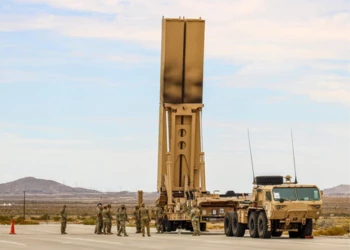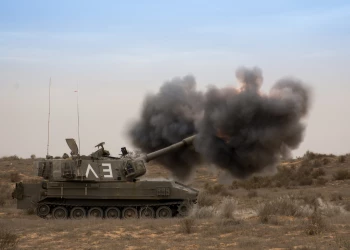A History of Modernizing and Replacing the Bradley Fighting Vehicle
Add bookmark
The Bradley Fighting Vehicle has been synonymous with American military excellence over the past 40 years. The “Bradley” has been used for transporting troops to critical battlefield points, providing fire coverage for dismounting troops, and delivering offensive attack capability at enemy armored vehicles and troops. There are two models of the Bradley. The M2 Infantry Fighting Vehicle (IFV) is designed for troop transport, while the M3 Cavalry Fighting Vehicle (CFV) is deployed for reconnaissance missions and tank combat.
While both iterations of the Bradley have been key to the US military since their deployment in the 1980s, the Army has long expressed a need to replace the vehicles with a new ground combat vehicle. This article will track the failed Army efforts to replace the Bradley and why the latest effort might yield different results.
If you’re interested in hearing directly from Army leaders regarding the future of the Bradley vehicles, be sure to register for IDGA’s Armored Vehicle Summit this June 24-25 in Detroit, Michigan. The two-day event serves as a US-centered platform for the comprehensive discussion of everything armored vehicle-related, covering strategic issues to the threat environment, the challenges of MRO, and lifecycle management all the way through to the next generation of ‘optionally manned’ combat vehicles.
Unsuccessful efforts to establish a new Ground Combat Vehicle
The Bradley Fighting Vehicle is part of the “Big Five” weapons systems that includes the Abrams main battle tank, the Apache attack helicopter, the Black Hawk utility helicopter, and the Patriot air defense missile system. These systems are considered the gold standard of the US military’s ground combat capability.
The Bradley M2 and M3 were a Cold War creation first introduced in 1981. Since then the vehicles have been in multiple conflicts, including Operation Desert Storm and post-9/11 wars. The vehicles are still in use today. Most recently in 2023, the US announced plans to offering enhanced protection, firepower, and operational flexibility compared to existing Ukrainian vehicles.
Despite the successful 40-year track record of the Bradley Fighting Vehicle, the DoD has made multiple efforts in the 21st century to modernize or replace both iterations of the vehicle. In this section we’ll look at some of these attempts and determine what led to their ultimate failure.
M247 Sergeant York
The M247 Sergeant York was designed to operate alongside advanced systems like the M1 Abrams tank and the M2 Bradley IFV. M247 was envisioned as a counterpart to the vehicles to protect armored formations from aerial threats, especially attack helicopters and low-flying aircraft.
However, the M247's chassis was based on the older M48 Patton tank rather than the advanced mobility systems of the Bradley and Abrams. This decision significantly impacted its ability to integrate operationally with these newer vehicles, particularly in fast-moving battlefield scenarios.
Cost overruns and delays further diminished confidence in the program. Originally envisioned as a cost-effective and timely solution, the M247 became an expensive endeavor with no guarantee of resolving its operational deficiencies. These factors, combined with evolving threat landscapes and the Army’s dissatisfaction with its performance, ultimately led to the cancellation of the program in 1985 after only 50 units were produced.
XM2001 Crusader
The XM2001 Crusader was a next-generation self-propelled howitzer (SPH) developed by the Army. It aimed to modernize artillery capabilities by improving survivability, lethality, mobility, and overall effectiveness on the battlefield. Designed as a replacement for the M109A6 Paladin and M992 Field Artillery Ammunition Support Vehicle, the Crusader was initially scheduled for fielding by 2008 and featured advanced technologies such as a cooled 155mm XM297E2 cannon, automated ammunition handling, and a cockpit with embedded command and control.
The Crusader shared a conceptual lineage with the Bradley Fighting Vehicle through its origins in the Armored Systems Modernization program. However, the Crusader program faced significant setbacks and challenges that ultimately led to its cancellation.
One of the key reasons for the Crusader’s failure was its weight. The combined weight of the howitzer and its resupply vehicle exceeded 110 tons, far more than the capacity of most US Air Force aircrafts. The program also faced redundancy concerns due to parallel advancements in artillery technology, including the development of lighter, more mobile systems under the Future Combat Systems initiative. Critics argued that the Crusader's capabilities did not justify its high cost, estimated at $11 billion for 480 units, especially when lighter and potentially more versatile systems were being explored.
In May 2002, Secretary of Defense Donald Rumsfeld canceled the Crusader program, citing its inability to align with the priorities of a modernizing and more expeditionary Army.
Future Combat Systems
The Army’s Future Combat Systems (FCS) is considered one of the largest failures during the military’s efforts to revolutionize its ground combat capabilities. The program was launched in 2003 and sought to integrate new manned and unmanned vehicles and other technologies into a unified network to enhance battlefield effectiveness. The program was the Army's largest modernization initiative since World War II and had a projected cost of $340 billion.
One of the objectives of the FCS program was to replace aging platforms like the Bradley Fighting Vehicle and the M1 Abrams Main Battle Tank. The envisioned replacement was a family of lightweight, networked Manned Ground Vehicles (MGVs). These vehicles were designed to operate seamlessly within the FCS framework, emphasizing mobility, advanced sensors, and data connectivity.
The FCS program was canceled in 2009 primarily for being unaffordable. Other challenges include the program being overly ambitious from a technology maturity standpoint, overly complex from a program management standpoint, and failing to reflect current emerging threat requirements from conflicts in Iraq and Afghanistan. $32 billion had been spent when the program was canceled.
Ground Combat Vehicle
The Ground Combat Vehicle (GCV) program was a U.S. Army initiative launched in 2009 to develop a next-generation infantry fighting vehicle (IFV) as a replacement for the M2 Bradley Fighting Vehicle.
The GCV was intended to address the limitations of the Bradley, particularly its inability to transport a full nine-member squad of infantry. The GCV sought to integrate superior armor, better survivability features, and cutting-edge technology while maintaining the Bradley's role as a versatile combat platform.
The GCV program faced numerous challenges that ultimately led to its cancellation in 2014. A significant obstacle was the vehicle's design, which prioritized heavy armor and the capacity to transport a fully equipped squad of nine soldiers. While this addressed a key shortfall of the M2 Bradley, it resulted in substantial weight increases, raising concerns about the GCV's mobility and deployability in diverse operational environments. This issue was compounded by the Army's insistence on incorporating advanced technologies that further increased the program's complexity and cost.
Funding constraints also played a critical role in the program's failure. The GCV was launched during a period of intense budgetary pressure on the Department of Defense, and the program's projected costs quickly ballooned, making it an unsustainable initiative. Additionally, the GCV program inherited skepticism from the aforementioned cancellation of the FCS initiative, which had failed due to similar issues of over-ambition and misalignment with budgetary realities.
When the initiative was canceled in 2014, resources previously allocated to the GCV were redirected toward upgrading the Bradley Fighting Vehicle and developing the Armored Multi-Purpose Vehicle (AMPV).
Ongoing Program
Since the cancellation of GCV in 2014, the Army has determined future infantry-fighting vehicle programs need more modest program goals at the onset and limit the list of new technologies to avoid criticism for costs and design. This section will look at a couple of those programs who are looking to succeed given the experience the Army gained from previous failures.
Next Generation Combat Vehicle
The Next Generation Combat Vehicle (NGCV) is the Army’s program of choice to correct years of military efforts to modernize combat vehicle capabilities.
Launched in 2017 after the cancellation of the GCV program, the NGCV program is a comprehensive effort designed to replace critical vehicles like the M113 armored personnel carrier, the M2 Bradley Infantry Fighting Vehicle, and the M1 Abrams main battle tank. Central to the NGCV program is the replacement of the M2 Bradley with the XM30 Mechanized Infantry Combat Vehicle (MICV).
The XM30 is designed to overcome the Bradley's limitations, such as insufficient survivability and mobility, while integrating modern technologies like advanced sensors, an updated weapons system, and an optionally manned capability.
The NGCV program has implemented measures to mitigate the risks associated with developing a new combat vehicle following the cancellation of GCV and FCS. It adopts a phased development approach, where contracts are awarded to multiple competitors to foster innovation and ensure robust prototypes. For example, the XM30 competition includes companies like General Dynamics Land Systems and American Rheinmetall, who are developing prototypes with clear performance benchmarks. This approach reduces the likelihood of a single failure derailing the program. Additionally, the NGCV prioritizes realistic requirements and incremental technological integration, avoiding the pitfalls of over-complex designs. By incorporating lessons learned from previous cancellations, the program emphasizes modularity, digital design twins, and rigorous testing to ensure vehicles meet operational demands.
Ongoing challenges for NGCV
Despite its ambitious goals, NGCV has faced significant challenges, reflecting broader issues in the Army’s efforts to modernize its ground combat fleet. The original competition phase was hampered by aggressive deadlines and overly ambitious objectives, such as requiring the vehicle to fit two units in a single C-17 transport aircraft. These stringent requirements led to the disqualification of early prototypes that failed to meet weight and delivery standards. Furthermore, the Army's initial approach placed a disproportionate share of development costs on private contractors, which discouraged participation from major industry players and further hindered progress.
The program has also been characterized by frequent resets and shifting strategies. After the initial effort faltered, the Army announced a complete restart in 2020, which introduced delays and increased costs while also making it more difficult to maintain consistent goals. Budgetary constraints and changing requirements further complicated the process. Delayed acquisition decisions meant that the Army often prioritized short-term solutions over long-term modernization while evolving program priorities—including the transition from the OMFV designation to the NGCV framework and eventually to the XM30 MICV—created additional uncertainty.
Learn More About Armored Vehicle USA

Armored Vehicles USA 2026 returns to Detroit, Michigan on June 23–24, uniting over 400 senior military leaders, acquisition professionals, and industry experts for two days of strategic briefings, technical discussions, and solution-oriented collaboration.
Learn More




















